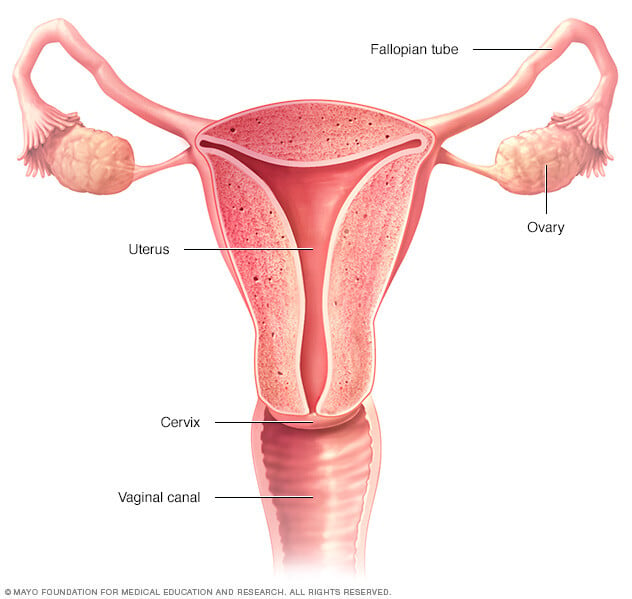Mittelschmerz
Overview

Mittelschmerz is one-sided, lower abdominal pain associated with ovulation. German for "middle pain," mittelschmerz occurs midway through a menstrual cycle — about 14 days before your next menstrual period.
In most cases, mittelschmerz doesn't require medical attention. For minor mittelschmerz discomfort, over-the-counter pain relievers and home remedies are often effective. If your mittelschmerz pain is troublesome, your doctor may prescribe an oral contraceptive to stop ovulation and prevent midcycle pain.
Symptoms
Mittelschmerz pain usually lasts a few minutes to a few hours, but it may continue for as long as a day or two. Pain from mittelschmerz may be:
- On one side of your lower abdomen
- Dull and achy, similar to menstrual cramps
- Sharp and sudden
- Accompanied by slight vaginal bleeding or discharge
- Rarely, severe
Mittelschmerz pain occurs on the side of the ovary that's releasing an egg (ovulating). The pain may switch sides every other month, or you may feel pain on the same side for several months.
Keep track of your menstrual cycle for several months and note when you feel lower abdominal pain. If it occurs midcycle and goes away without treatment, it's most likely mittelschmerz.
When to see a doctor
Mittelschmerz rarely requires medical intervention. However, contact your doctor if a new pelvic pain becomes severe, if it's accompanied by nausea or fever, or if it persists — any of which could indicate you have a condition more serious than mittelschmerz, such as appendicitis, pelvic inflammatory disease or even an ectopic pregnancy.
Causes
Mittelschmerz occurs during ovulation, when the follicle ruptures and releases its egg. Some women have mittelschmerz every month; others have it only occasionally.
The exact cause of mittelschmerz is unknown, but possible reasons for the pain include these:
- Just before an egg is released with ovulation, follicle growth stretches the surface of your ovary, causing pain.
- Blood or fluid released from the ruptured follicle irritates the lining of your abdomen (peritoneum), leading to pain.
Pain at any other point in your menstrual cycle isn't mittelschmerz. It may be normal menstrual cramping (dysmenorrhea) if it occurs during your period, or it may be from other abdominal or pelvic problems. If you have severe pain, see your doctor.
Risk factors
Mittelschmerz has no clear risk factors. But it may be more likely to happen between the ages of 15 and 25.
Complications
Mittelschmerz doesn't lead to other health conditions, also called complications. The pain goes away on its own, or with medicine or home remedies.
Prevention
Mittelschmerz can't be prevented. It's linked with natural changes in the body that happen during the menstrual cycle.
Diagnosis

To diagnose mittelschmerz, your doctor will start by asking you questions to get a clear idea of your medical history, especially regarding your menstrual periods. Your doctor may also perform a physical exam, including a pelvic exam, to check for signs of an underlying condition that could be contributing to the pain.
Treatment
Possible treatments for mittelschmerz include:
- Pain relievers. For the relief of discomfort from mittelschmerz, try an over-the-counter drug such as acetaminophen (Tylenol, others), aspirin, ibuprofen (Advil, Motrin IB, others) or naproxen sodium (Aleve).
- Birth control pills (oral contraceptives). If mittelschmerz causes you a lot of discomfort or occurs monthly, ask your doctor about taking birth control pills. Some types of birth control pills suppress ovulation, which could help ease ovulation pain while you're taking them.
Lifestyle and home remedies
To ease mittelschmerz discomfort that lasts more than a few minutes, try some home remedies. Because heat increases blood flow, relaxes tense muscles and eases cramping, you might want to:
- Soak in a hot bath
- Use a heating pad where the pain is
Preparing for an appointment
In most cases, you won't need to see a doctor for mittelschmerz. However, if your pain is especially troublesome, you may make an appointment to confirm a diagnosis of mittelschmerz or to explore treatment options.
What you can do
You may want to write a list that includes:
- Detailed descriptions of your symptoms
- The dates when your last two menstrual periods began
- Information about medical problems you've had
- Information about the medical problems of your parents or siblings
- All the medications and dietary supplements you take
- Questions to ask the doctor
Preparing a list of questions for your doctor will help you make the most of your time together. For mittelschmerz, some basic questions to ask include:
- What is likely causing my symptoms?
- Are there other possible causes for my symptoms?
- Are my symptoms likely to change over time?
- Do I need tests?
- What treatments or home remedies might help?
- Do you have brochures or other printed materials I can have? What websites do you recommend?
Don't hesitate to ask other questions, as well.
What to expect from your doctor
Your doctor is likely to ask you a number of questions, such as:
- How many days apart are your menstrual periods, and how long do they last?
- How would you describe your symptoms?
- Where is your pain?
- How long have you been experiencing this pain? Is it constant or does it subside after a few minutes or hours?
- On a scale of 1 to 10, how severe is your pain?
- How long before or after your period does the pain occur?
- Do you have other symptoms, such as nausea, vomiting, diarrhea, back pain, dizziness or headache?



